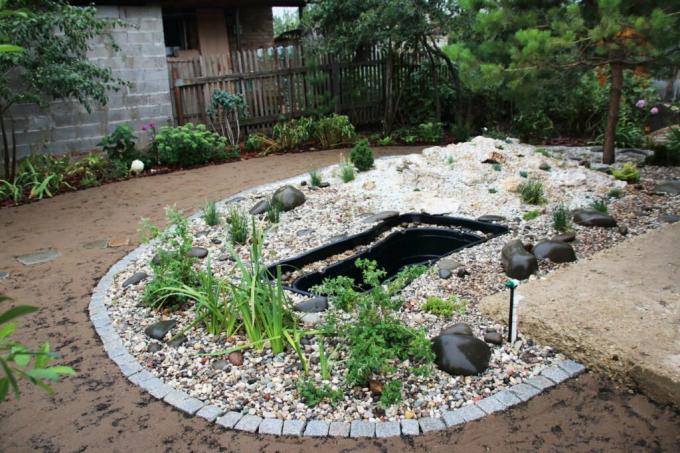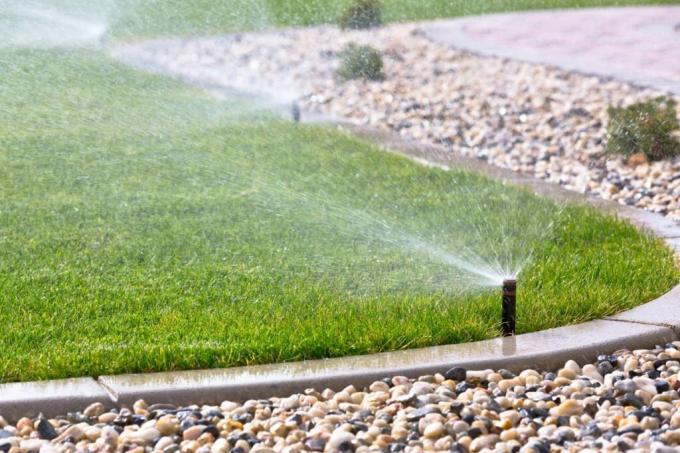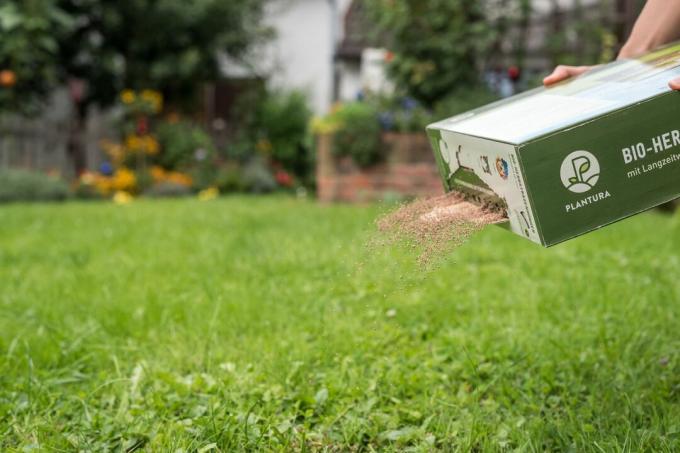If you want to create a new lawn or repair it, you can sow lawn seeds. Here you will find instructions with expert tips.

Sowing the lawn is still the most popular way to create a lawn. And lawn seeds should also be used occasionally in areas that already exist. It is particularly important to select the right time and the right lawn seeds. Watering and further care after sowing are also crucial. And even years after sowing the lawn, one can Overseeding become necessary to let the lawn shine again in its old splendor. Therefore we provide you with all the important information and tips about sowing and overseeding lawns below.
contents
- 1. When should you sow the lawn?
-
2. What should you watch out for before sowing the lawn?
- Dig up the soil before sowing the lawn
-
Prepare the soil for sowing the lawn
- Prepare normal soils for sowing the lawn
- Prepare very heavy and loamy soils for sowing the lawn
- Prepare compacted soils for sowing the lawn
- Prepare very light soils for sowing the lawn
- Measure the pH two months before sowing the lawn
- Prepare the soil one to two weeks before sowing the lawn
- 3. Choosing the right lawn seeds
-
4. Spreading lawn seeds correctly: by hand or with a spreader
- Spreading lawn seeds by hand
- Spread lawn seeds with the spreader
- 5. Water the lawn after sowing
- 6. Maintain lawn properly after sowing
Starting with the question of when it makes most sense to sow the lawn, you will find six steps below to successfully sow your lawn. In addition, we provide you with a few care tips so that your lawn will be healthy and strong after sowing.
1. When should you sow the lawn?
Generally speaking, lawns can be sown from April to October. The ideal times are early autumn and spring, when the soil is warm enough. Most grasses need a minimum soil temperature of 8 ° C for germination, 14 to 25 ° C and sufficient moisture are optimal. These conditions are most likely to occur in late summer or early autumn, which is why this time of year is best suited for sowing the lawn. But it shouldn't be too late in autumn either, as the seeds could otherwise emerge incompletely or unevenly due to the cold.
tip: The small grasses sown in early autumn are just as frost-resistant as the older lawn. Only during the sensitive phase of germination and emergence should the soil temperatures not be below 8 ° C - soil frost is therefore a major risk factor.

In addition to autumn, spring is also suitable for sowing lawns. From the middle of April to the beginning of May, the soil temperatures are optimal, but care must be taken to ensure that there is sufficient moisture. Strong heat waves in early June can easily damage the young lawn.
At a glance: When should you sow the lawn?
- Lawn can be sown either in autumn (September) or in spring (mid-April to early May)
- The soil temperatures during germination should be at least 8 to 12 ° C
- The soil should be dry when sowing, but should be watered soon afterwards
2. What should you watch out for before sowing the lawn?
Before laying the lawn, all work in the garden that could put a strain on a young lawn should be completed. Once the fruit trees have been planted and beds, paths or garden ponds have been created, you can start.
Dig up the soil before sowing the lawn
For each area on which the lawn is to grow later, soil preparation begins with digging deep into the spade using a spade or a digging fork. On large, contiguous areas, a power tiller or cultivator makes work a lot easier. Many hardware stores, for example, lend suitable equipment. Autumn is the best time for digging when the soil is well dried and crumbly and the following winter promises a good frost bake of the soil. During the digging, all foreign bodies, weeds and large stones should be removed from the ground so that the necessary soil improvement can be carried out. Below in this article you will find out which soil improvement you need. It is ideal if there are a few months between digging and sowing so that the soil can settle and the lawn does not sink later.

Tip: If the later lawn is overgrown with root weeds such as couch grass or groundgrass, the areas overgrown with them should not be milled. Their rhizomes would be divided up by the milling machine and spread over the surface. It is better to dig these areas up by hand and meticulously remove every root.
Prepare the soil for sowing the lawn
The soil under the lawn will have to perform well for years, because a lawn needs a lot of nutrients, depletes the soil and allows it to dry out easily. Therefore, regardless of fertilization and preparation, the soil must also be prepared during the actual sowing. We will now explain to you which soil should be treated and how.
Prepare normal soils for sowing the lawn
Normal floors become predominant through a gift organic fertilizer prepared. A soil activator with beneficial mycorrhizal fungi like ours is particularly suitable Plantura organic soil activator. The high content of organic matter ensures a loose soil structure and increases the humus content. Alternatively, there is also a compost- or Manure dung as fertilizer possible: 10 to 15 liters per square meter are worked into the top 10 to 20 centimeters.
Prepare very heavy and loamy soils for sowing the lawn
Heavy soils are rich in clay and are characterized by the fact that they become hard as stone when it is dry and stick to the boots in greasy, heavy lumps when it is wet. Such soils provide lawns with a lot of nutrients, but not enough water and oxygen at the roots. Extremely heavy soils can contain up to 50 liters of sand per m², like ours Plantura Premium lawn sand, modified so that the creation of a lawn is possible. Alternatively, lava or expanded clay are also suitable. In addition, as on normal soils, mainly organic fertilizers such as Plantura are used Organic soil activator or incorporated compost.
Prepare compacted soils for sowing the lawn
Compacted soils were compressed so tightly by high pressure and unfavorable soil properties that they hardly absorb or let through water and air. You benefit greatly from one Green manure. In late summer you sow strongly rooted plants that will die in the following winter, for example lupine (Lupinus) or Oil radish (Raphanus sativus var. oleiformis). By next spring, the plant remains will weather and largely decompose to the point where the lawn is sown. Alternatively, highly compacted soils can also be aerated, that is ventilated will. Finally, in both cases, sand and one primarily organic fertilizer like ours Plantura organic soil activator or compost be introduced.

Prepare very light soils for sowing the lawn
Very sandy, nutrient-poor areas are not optimally prepared for lawn growth. In such areas, nutrient storage and water retention capacity must be improved. One Green manure with nitrogen-gathering legumes is highly recommended. In addition to the green manure, the incorporation of a primarily organic organic fertilizer with long-term effects, such as ours Plantura organic soil activator, take place. Alternatively, 20 to 30 liters of mature compost or three to five kilograms of mature manure per square meter can be incorporated a few days before sowing.
Tip: Even with the improvement mentioned above, soils that are light and sandy from the outset cannot be fundamentally turned inside out. Therefore, the use of an adapted lawn seed mixture for dry locations is the best choice later. Hence we have our drought tolerant Plantura dry grass developed.
Measure the pH two months before sowing the lawn
Use a soil pH test to test the pH of your soil. Most grasses like a score of around 5.5 to 7. We explain everything to you in our special articles Lawn lime and Lawn fertilizers.
Prepare the soil one to two weeks before sowing the lawn
Coarse unevenness must be smoothed out, they say: The rough level is created. Because this can be tedious with a shovel and rake and it may be necessary to use a machine, a specialist should be asked for help if necessary.
The last step before sowing is the even and careful leveling of the future lawn area. For this purpose, a wooden rake is used, with which connections to the edges of paved surfaces are made flush or with a maximum of 2 cm shelter and also carefully pressed on. This step is also called creating the fine subgrade.
Tip: Perhaps you were a little late with digging and the area has not yet settled properly? Then, in front of the fine subgrade, rolling or pressing down with step boards must be carried out. If the surface sags unevenly, these unevenness can still be leveled out.
At a glance: What should you watch out for before sowing the lawn?
- All work that would stress the young lawn must be completed
- Before sowing the lawn, the soil is dug or milled as deep as a spade; root weeds must be carefully removed
- Sand, lava or expanded clay are placed on heavy loam and clay soils
- Very light soils can handle a lot compost or Green manure be improved
- Heavily compacted soils are made by a green manure or by Aeration prepared for sowing
- All soils benefit primarily from the application of a organic fertilizer like ours Plantura organic soil activator
- Two months before sowing the lawn, the pH value of the soil is measured and adjusted if necessary
- The rough subgrade is carried out a maximum of four weeks before sowing
- If the soil has not settled long enough after digging, it is rolled or pressed
- Finally, before sowing, the fine subgrade is created with a wooden rake

3. Choosing the right lawn seeds
Lawn seeds are sold in seed mixes. Lawn is not made up of a single type of grass, but rather a mixture of different types of grass, each of which contributes its part to the perfect, dense surface. With the choice of the lawn seed mixture you have a decisive influence on the quality and shape of your future lawn. Because these vary depending on what use is intended. Finally a must Play and sports turf Withstand completely different loads than an ornamental lawn that is rarely used. And luckily there are adapted seed mixes for Shadow lawn or Dry grass for gardens in which no normal lawn could otherwise grow. Our Plantura lawn family includes lawn seed mixtures for various areas of application and also provides you with all the important information about use and care.
We recommend a so-called standard seed mixture (RSM). This seal has been tested and therefore promises quality in terms of germination and a good composition of grass species. Feel free to spend one euro more on high-quality seeds - the result will definitely speak for itself later. Also ours Plantura lawn seed mixtures are of course RSM certified.
At a glance: which lawn seed is the right one?
- Depending on whether you want to re-sow, create lawn in the shade of trees or play and use lawns, there are various seed mixtures to choose from
- It is worth investing in high-quality standard seed mixtures (RSM)

4. Spreading lawn seeds correctly: by hand or with a spreader
The perfect weather for sowing the lawn is warm, not hot, and light rainfall should be registered - alternatively, the lawn sprinkler can do it. In addition, the soil should be well moist. If this is the case, the sowing can begin. If you fertilize your lawn primarily organically, you distribute 100 grams per square meter of ours directly beforehand, for example Plantura organic lawn fertilizer. The correct seed density is then of great importance for the subsequent sowing. If the optimal amount of seed is not applied, this can lead to an uneven lawn appearance in the long term. The sowing is done either by hand or with a spreader.
Spreading lawn seeds by hand
If you have a rather small area to sow and want to do it by hand, do the following: Measure an area of one square meter and weigh out the correct amount of seeds (the seed mix is usually the amount per square meter specified). Distribute the amount evenly over the surface. This will give you a sense of how close the seeds should be. Divide the remaining area into pieces or strips and measure the seeds to match the area. Sow your entire future lawn in longitudinal and transverse rows.
Lawn seeds with to the Spread spreader
The use of a spreader simplifies the precise distribution of the lawn seeds over large areas. Here's what to do if you have a spreader.
Expert tip: This is how you set the spreading strength of the spreader perfectly: Prepare a sheet or sheet of several square meters that you can test drive over with the spreader. Fill the spreader and drive so far that the piece of film you drive on corresponds to one square meter. Now pour the seeds from the foil into a container and weigh them. Depending on how far your result is from the recommendation of the amount per square meter of your seed mixture, adjust the seed strength of the spreader.

After sowing, the lawn seeds will either be thin with ours Plantura turf soil covered, which creates optimal starting conditions for the young lawn. Alternatively, the seeds are worked shallowly - 0.5 to 1 cm deep - into the soil with a rake to protect them from drying out and being eaten by birds. The soil connection is then established: the seed must be in contact with the soil in order to be able to absorb water for germination. This is achieved with a light roller or running boards.
At a glance: How are lawn seeds properly applied?
- The soil should be moist, but the surface should be dry and crumbly.
- Mainly organic lawn fertilizer like ours Plantura organic lawn fertilizer is distributed just before sowing.
- Depending on the seed mixture used, a specific seed density indicated on the package is recommended. For our Plantura sports and play lawn For example, 20 grams of seeds are required per square meter.
- It can be sown by hand or with a spreader. The spreader ensures a more even result on large areas.
- After sowing, the seeds are covered with special turf soil or worked in and then pressed on.
5. Water the lawn after sowing
After sowing, a continuous supply of moisture ensures that the germination process begins and continues. You should water every day for about a month, unless it is raining. However, the soil must not be submerged either, otherwise the oxygen supply to the seeds is endangered. In dry weather it is advisable to water two to three times a day for about 10 to 15 minutes with the finest watering setting.

At a glance: How is the lawn properly watered after sowing?
- A continuous supply of moisture without submerging the lawn is ideal for the lawn
- The freshly sown lawn is still sensitive, which is why caution is advised with hoses and the like
6. Maintain lawn properly after sowing
With the conscientious preparation and sowing of the right ones Lawn seed mix you can lay a significant foundation stone for a beautiful, dense lawn. Proper lawn care is essential to maintain this beauty.
Regular lawn care is also a part of it mowing. Mulching or mowing ensures that the lawn is constantly being planted from below. The vast majority of weeds do not tolerate constant beheading and are suppressed. Stubborn guests like couch grass, dandelion or Ribwort plantain however, you should stand out.
The first cut is carried out at a height of 6 to 10 cm and at a cutting height of 4 cm. Pay attention to sharp mower blades, because blunt ones pull the young grass plants out of the ground. After the second or third cut, organic fertilization should be carried out - however, note the time of year: After October, organic fertilization will no longer be used.
tip: It is better to mow regularly so that the grass does not get too long. Otherwise, the fast-growing species take away the light from the so-called undersea grasses, so that they perish. A lawn thinned in this way should have a Overseeding be revived, as otherwise weeds can easily take the place of the undergrass.
As a heavy consumer, your lawn needs a high supply of nutrients in order to be healthy and competitive with weeds. For this reason, fertilization is usually carried out two to three times a year. Mainly organic fertilizers like ours Plantura organic fertilizer However, they have a naturally long-term effect, so that in an emergency you can even fertilize the lawn with a single large dose a year.

Tip for lazy lawn owners: In principle, regular, sufficient fertilization is primarily important organic lawn fertilizer the perfect prophylaxis against moss and thatch or weeds. This saves you even the regular one Scarifying or Sands - both represent an avoidable effort. Our Plantura organic lawn fertilizer ensures active soil life all year round, which loosens the soil, provides nutrients and eats thatch. The counterpart for autumn is our Plantura organic autumn lawn fertilizer, whose increased potassium content ensures frost-hardy grasses.
At a glance:How is the sown lawn properly cared for?
- The first cut is made when the plant is 6 to 10 cm tall
- For the second or third cut, the lawn should be fertilized - depending on the season with our mainly organic Plantura Organic lawn fertilizer or Plantura Organic autumn lawn fertilizer
- Between spring and autumn should be a regular one Lawn clippings take place
- For all the years to come, your lawn will need fertilization 2 to 3 times a year in order to grow healthy and dense
- Organic lawn fertilization is prophylaxis and often saves you from scarifying in the future
Tip: Your lawn has one or more large gaps because a heavy object has been stored on it or the mole has been up to mischief? In this case, we recommend sowing a fast-germinating mixture that will quickly close the hole. Our Plantura lawn repair consists mainly of fast germinating ryegrass and competitive red fescue. Both do not give any weeds a chance.
To keep your lawn healthy and strong after sowing, you can find more information about the Lawn care all year round.



